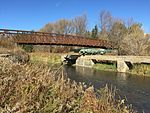Holland Landing Airpark
Holland Landing Airpark (formerly Hare Field) (TC LID: CLA4) is located adjacent to the south end of Holland Landing, Ontario, Canada. The airport is mainly used for training but tenants also offer charter, advertising and sightseeing services. The largest building is a 30,000 sq ft (2,800 m2) hangar owned by Silverline Helicopters. The smaller hangar belongs to Future Air. The 40 acres (16 ha) private airfield is being shortlisted as a future home for York Regional Police Air2 helicopter.The original 1,900 ft (580 m) grass strip was constructed by Wallace G. Hare in 1956 and a second, shorter 1,200 ft (370 m) runway was added shortly after. It served as a private airstrip for a handful of local pilots and grew to housing up to 20 private aircraft at its peak. In 1978, ultralights were becoming popular and two local ultralight companies set up their businesses on Hare Field. In 2006, Hare Field was sold to Silverline Helicopters and became known as Holland Landing Airpark.
Excerpt from the Wikipedia article Holland Landing Airpark (License: CC BY-SA 3.0, Authors).Holland Landing Airpark
Tremoy Road, East Gwillimbury
Geographical coordinates (GPS) Address External links Nearby Places Show on map
Geographical coordinates (GPS)
| Latitude | Longitude |
|---|---|
| N 44.089444444444 ° | E -79.495 ° |
Address
Holland Landing Airpark
Tremoy Road
L9N 1K9 East Gwillimbury
Ontario, Canada
Open on Google Maps






